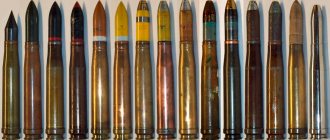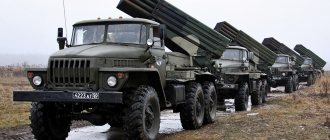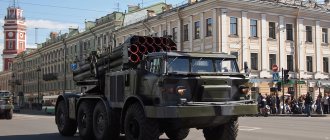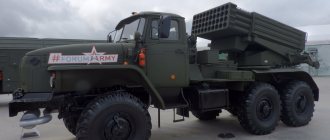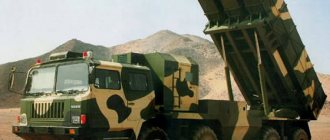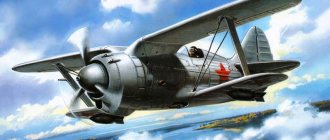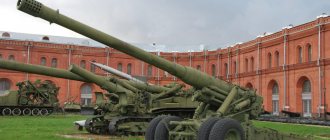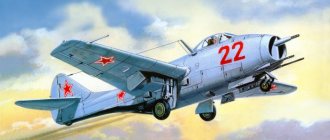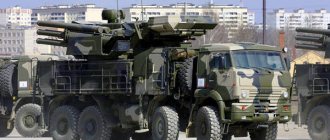Use of captured German mortars and multiple launch rocket systems
In the comments to the publication The Use of German Armored Vehicles in the Post-War Period, I recklessly announced that the last article in the series would talk about the use of captured German artillery.
However, having assessed the amount of information, I came to the conclusion that it was necessary to make a breakdown of mortars, field, anti-tank and anti-aircraft artillery. In this regard, at least three more articles dedicated to captured German artillery systems will be presented to readers.
Today we will look at German mortars and multiple launch rocket systems.
50 mm mortar 5 cm le.Gr.W. 36
In the initial period of the war, our troops often captured German 50-mm mortars 5 cm le.Gr.W. 36 (German: 5cm leichter Granatenwerfer 36). This mortar was created by designers of Rheinmetall-Borsig AG in 1934, and put into service in 1936. Mortar 5 cm le.Gr.W. 36 had a “solid” design - that is, all the elements were placed on a single carriage. The 460 mm long barrel and other mechanisms are mounted on a base plate. For guidance, a spindle adjustable in height and direction was used. The mass of the mortar in firing position was 14 kg. The mortar was served by two people who were assigned an ammunition carrier.
50 mm mortar 5 cm le.Gr.W.
36 The initial speed of a 50-mm mine weighing 910 g was 75 m/s. Maximum firing range – 575 m. Minimum – 25 m. Vertical aiming angles: 42° – 90°. In the horizontal plane: 4°. Rough aiming was carried out by turning the base plate.
A well-trained crew could fire 20 rounds per minute. The combat rate of fire with aiming correction did not exceed 12 rounds/min. The fragmentation mine, containing 115 g of cast TNT, had a damage radius of about 5 m.
The Wehrmacht command considered the 50-mm mortar as a means of fire support for the company-platoon level. And she had high hopes for him.
According to the 1941 staffing schedule, each rifle company was supposed to have three mortars. The infantry division was to have 84 50 mm mortars.
On September 1, 1939, the troops had about 6,000 company mortars. As of April 1, 1941, there were 14,913 50-mm mortars and 31,982,200 rounds available.
However, the 50-mm mortar as a whole did not justify itself.
Its firing range roughly corresponded to the range of effective rifle and machine gun fire, which made mortar crews vulnerable and reduced combat value. The fragmentation effect of the shells left much to be desired, and the high-explosive effect was not enough to destroy light field fortifications and wire barriers.
During the fighting, it also became clear that mine fuses did not have the required level of reliability and safety. There were often cases when mines did not explode when they hit liquid mud and a deep snowdrift. Or vice versa - detonation occurred immediately after the shot, which was fraught with the death of the crew. Due to the fuse being too sensitive, firing in the rain was prohibited.
Due to low efficiency and unsatisfactory safety, in 1943 the production of 5 cm le.Gr.W mortars. 36 were rolled up.
The remaining 50-mm mortars were used to a limited extent until the end of hostilities.
However, in the second half of the war, the Red Army also abandoned company mortars. And the remaining 50-mm mines were converted into hand grenades.
It cannot be said that captured 50-mm mortars were popular among the Red Army soldiers.
German company mortars were sometimes used as a freelance means of fire reinforcement in long-term defense.
In the summer and autumn of 1944, there were cases of successful combat use of light mortars in street battles. Captured mortars were installed on the upper armor of T-70 light tanks and were used to fight enemy infantry holed up in the attics and roofs of buildings.
Based on this, BTU GBTU specialists, who analyzed combat experience, recommended continuing to use captured 50-mm mortars in units of the Red Army armored forces participating in battles for cities.
The partisans used company mortars to shell German strongholds in the occupied territory. Relatively light 50mm mortars were well suited for this. Having fired a dozen mines from the maximum distance, it was possible to quickly retreat.
81 mm mortar 8 cm sGW 34
Much more powerful (compared to the 50 mm) was the 81 mm 8 cm sGW 34 mortar (German: 8 cm Granatwerfer 34).
The mortar was created in 1932 by Rheinmetall-Borsig AG. And in 1934 it entered service. In the period from 1937 to 1945. German industry produced more than 70,000 81-mm mortars, which were used on all fronts.
The 8 cm sGW 34 mortar had a classic design according to the scheme
"imaginary triangle"
and consisted of a barrel with a breech, a base plate, a bipod and a sight.
A biped-carriage consisting of two supporting legs identical in design (due to the presence of a hinged joint) allows for rough installation of vertical pointing angles. The exact installation was carried out using a lifting mechanism.
81-mm mortar 8 cm sGW 34
In combat position, the 8 cm sGW 34 mortar weighed 62 kg (57 kg using light alloy parts).
And could do up to 25 rounds/min. Vertical aiming angles: from 45 to 87°. Horizontal aiming: 10°. A mine weighing 3.5 kg left a barrel 1143 mm long with an initial speed of 211 m/s, which made it possible to hit targets at a range of up to 2400 m.
In the second half of the war, an enhanced propellant charge was introduced with a firing range of up to 3000 m.
The ammunition included fragmentation and smoke mines.
In 1939, a bouncing fragmentation mine was created, which, after falling, was thrown up by a special powder charge and detonated at a height of 1.5–2 m.
An air blast ensured a more effective defeat of manpower hidden in craters and trenches, and also made it possible to avoid the negative influence of snow cover on the formation of a fragmentation field.
81 mm fragmentation mines 8 cm Wgr. 34 and 8 cm Wgr. 38 contained 460 g of cast TNT or ammatol. Fragmentation bouncing mine 8 cm Wgr. 39 was equipped with cast TNT or cast ammatol and a powder charge in the head. Explosive weight – 390 g, gunpowder – 16 g. Damage radius from fragments – up to 25 m.
Each Wehrmacht infantry battalion was supposed to have six 81-mm mortars. On September 1, 1939, the troops had 4,624 mortars. As of June 1, 1941, the Wehrmacht infantry divisions had 11,767 mortars.
Production of the 8 cm sGW34 continued until the end of the war.
On January 1, 1945, 16,454 mortars were registered.
The first cases of using captured 81-mm mortars were recorded in July 1941. In 1942, infantry battalions appeared in the Red Army, which were assigned batteries equipped with German-made mortars. In mid-1942, leaflets on use and instructions on combat use were published.
It is noteworthy that it was possible to fire German 81-mm mines from Soviet 82-mm battalion mortars. Since the ballistics of German and Soviet rounds differed, firing tables were issued for the use of 81 mm mines.
Red Army soldiers inspect a German 81-mm 8 cm sGW 34 mortar.
The Red Army quite intensively used captured 81-mm 8 cm sGW34 mortars against their former owners.
And (unlike the 50-mm mortars 5 cm le.Gr.W. 36) after the surrender of Germany, for the most part they were not sent for scrap. A significant number of German-made 81-mm mortars were available in the armed forces of Bulgaria, the Czech Republic and Romania in the first post-war decade.
In the second half of the 1940s, the Soviet Union donated several hundred captured German mortars to the Chinese communists waging an armed struggle against the Kuomintang. Subsequently, these mortars actively fought on the Korean Peninsula and were used against the French and Americans during the fighting in Southeast Asia.
In the 1960–1970s, there were cases when the Soviet government, not wanting to advertise cooperation with some national liberation movements, supplied them with foreign-made weapons, including German 81-mm 8 cm sGW 34 mortars.
120 mm mortar Gr.W. 42
In the initial period of the war, the Germans had a 105 mm 10.5 cm Nebelwerfer 35 mortar, which was structurally an enlarged 81 mm 8 cm sGW34 mortar and was originally developed for firing chemical ammunition.
Taking into account the fact that the top of the Third Reich did not dare to use chemical weapons, only fragmentation and high-explosive mines weighing 7.26–7.35 kg were used for firing.
The mass of the 105-mm mortar in firing position was 107 kg. And in terms of firing range it was slightly superior to the 81 mm 8 cm sGW 34 mortar.
In 1941, due to unsatisfactory range and excessive weight, production of the 105 mm 10.5 cm Nebelwerfer 35 mortar was discontinued.
At the same time, the Soviet regimental 120-mm mortar PM-38 made a great impression on the Germans.
PM-38 in combat position weighed 282 kg. The firing range was 460–5700 m. The rate of fire without aiming correction was 15 rounds/min. A high-explosive fragmentation mine weighing 15.7 kg contained up to 3 kg of TNT.
In 1941, advancing German troops captured large numbers of PM-38s. And they used trophies under the designation 12 cm Granatwerfer 378 (r). Subsequently, the Germans used the captured mortar very actively.
The Soviet PM-38 was so successful that the German command ordered it to be copied.
German mortar known as Gr.W. 42 (German: Granatwerfer 42) was produced at the Waffenwerke Brünn plant in Brno from January 1943.
At the same time, the transport trolley received a more durable design, adapted for towing by mechanical traction.
120 mm mortar Gr.W. 42 differed from the PM-38 in production technology and sighting devices. The mass of the mortar in firing position was 280 kg. Thanks to the use of a more powerful propellant charge and a mine lighter by 100 g, the maximum firing range increased to 6050 m.
But otherwise its combat characteristics corresponded to the Soviet prototype.
Wehrmacht soldiers next to a 120-mm Gr.W mortar. 42
From January 1943 to May to May 1945, 8461 120-mm Gr.W mortars were fired. 42.
During offensive operations, the Red Army captured several hundred clones of the Soviet PM-38 mortar produced in the Czech Republic. Taking into account the fact that for shooting from the German Gr.W. 42 and the Soviet PM-38 could use the same mines; there were no difficulties with supplying 120-mm mortars with ammunition.
In the post-war period (until the mid-1960s), captured Gr.W. 42 were used in Eastern European countries. And Czechoslovakia exported them to the Middle East.
150 mm rocket launcher 15 cm Nb.W. 41
Created before World War II in Germany, multiple launch rocket systems (MLRS) were originally intended to fire projectiles filled with chemical warfare agents and a smoke-forming composition for setting camouflage smoke screens.
This is reflected in the name of the first German serial 150-mm MLRS - Nebelwerfer (German: “Fog Thrower”) or “Smoke Mortar Type D”. During World War II, Germany was inferior to the Allies in terms of total reserves of accumulated chemical warfare agents.
At the same time, the high level of development of the German chemical industry and the presence of an excellent theoretical basis allowed German chemists to make a breakthrough in the field of chemical weapons in the late 1930s.
During research on the creation of insect control agents, the deadliest type of toxic substances in service was discovered - nerve poisons. Initially, it was possible to synthesize a substance later known as “Tabun”. Later, even more poisonous agents were created and produced on an industrial scale: Sarin and Soman.
Fortunately for the Allied armies, the use of toxic substances against them did not take place.
Germany, doomed to defeat the war by conventional means, did not try to turn the tide of the war in its favor with the help of the latest chemical weapons. For this reason, German MLRS used only high-explosive fragmentation, incendiary, smoke and propaganda mines for firing.
Testing of the 150mm six-barreled mortar and rocket mines began in 1937. And by the beginning of 1940, the “Fog Thrower” was brought to the required level of combat readiness.
This weapon was first used by the Germans during the French campaign. In 1942 (after the 28/32 cm Nebelwerfer 41 MLRS entered service), the installation was renamed 15 cm Nb.W. 41 (15 cm Nebelwerfer 41).
The installation was a package of six tubular guides 1300 mm long, combined into a block and mounted on a converted carriage of a 37 mm 3.7 cm Pak 35/36 anti-tank gun.
The rocket launcher had a vertical guidance mechanism with a maximum elevation angle of 45° and a rotating mechanism that provided a horizontal firing sector of 24°. In the combat position, the wheels were hung out, the carriage rested on the bipod of the sliding frames and the folding front stop. Loading took place from the breech. Sometimes, for better stability when firing from launchers, the wheel drive was removed.
Nebelwerfer 41
German designers managed to create a very light and compact rocket launcher. The combat weight in the loaded position reached 770 kg, in the stowed position this figure was 515 kg. The installation could be rolled over short distances by crew forces. The volley lasted about 10 seconds. A well-coordinated crew of 5 people could reload the gun in 90 seconds.
After pointing the mortar at the target, the crew went into cover and, using the launch unit, fired in series of 3 mines. When starting, the electric igniter is ignited remotely from the battery of the vehicle towing the unit.
For firing, 150-mm turbojet mines were used, which had a very unusual device for its time.
The combat charge, consisting of 2 kg of TNT, was located in the tail section, and in the front section was a solid-fuel jet engine with a fairing, equipped with a perforated bottom with 28 nozzles inclined at an angle of 14°. Stabilization of the projectile after launch was carried out due to rotation at a speed of about 1000 revolutions per second, provided by inclined nozzles.
The main difference between the German 15 cm Wurfgranete rocket mine and the Soviet M-8 and M-13 missiles was the method of stabilization in flight. Turbojet projectiles had a higher accuracy, since this method of stabilization made it possible at the same time to compensate for the eccentricity of the engine thrust. In addition, shorter guides could be used. Since, unlike missiles stabilized by fins, the effectiveness of stabilization did not depend on the initial speed of the missile. But due to the fact that part of the energy of the escaping gases was spent on spinning the projectile, the firing range was less than that of a finned rocket.
The maximum flight range of a high-explosive fragmentation rocket with a launch weight of 34.15 kg was 6700 m. The maximum flight speed was 340 m/s. The Nebelwerfer had very good accuracy for an MLRS of that time.
At a distance of 6000 m, the dispersion of shells along the front is 60–90 m, along the range – 80–100 m. The dispersion of lethal fragments during the explosion of a high-explosive fragmentation warhead was 40 meters along the front and 15 meters forward from the explosion site. Large fragments retained destructive power at a range of more than 200 m.
Relatively high shooting accuracy made it possible to use rocket-propelled mortars to fire not only area targets, but also point targets. Although, of course, with significantly less efficiency than a conventional artillery gun.
At the beginning of 1942, the Wehrmacht had three regiments of rocket mortars (three divisions each), as well as nine separate divisions. The division consisted of three fire batteries, 6 installations in each.
Since 1943, batteries of 150-mm rocket launchers began to be included in light battalions of artillery regiments of infantry divisions, replacing 105-mm field howitzers in them. As a rule, one division had two MLRS batteries, but in some cases their number was increased to three. In total, the German industry produced 5283 15 cm Nb.W rocket launchers. 41 and 5.5 million high-explosive fragmentation and smoke mines.
Six-barreled rocket mortars were very actively used on the Soviet-German front. On the Eastern Front, being in service with the 4th Special Purpose Chemical Regiment, from the first hours of the war they were used to shell the Brest Fortress and fired over 2,800 high-explosive rocket mines.
When fired from a 150-mm six-barreled mortar, the shells produced a clearly visible smoke trail, revealing the location of the firing position.
Considering that German MLRS were a priority target for our artillery, this was their big drawback.
210 mm rocket launcher 21 cm Nb.W. 42
In 1942, a 210-mm five-barreled 21 cm Nb.W rocket mortar entered service.
42. For firing from it, 21 cm Wurfgranate rocket mines were used, stabilized in flight by rotation. As with 150-mm rockets, the nozzles of the 210-mm rocket, located at an angle to the axis of the body, ensured its rotation. Structurally 210 mm installation 21 cm Nb.W. 42. had a lot in common with 15 cm Nb.W. 41 and was mounted on a similar carriage. In the combat position, the mass of the installation was 1100 kg, in the stowed position - 605 kg.
The salvo was fired within 8 s, reloading the mortar took about 90 s. The powder charge in the jet engine burned out in 1.8 s, accelerating the projectile to a speed of 320 m/s, which provided a flight range of 7850 m.
The reactive mine, the warhead of which contained up to 28.6 kg of cast TNT or amatol, had a strong destructive effect.
A German crew loads a 210 mm 21 cm Nb.W rocket launcher.
42 If necessary, it was possible to fire single shells, which made shooting easier. Also, with the help of special inserts, it was possible to fire 150-mm shells from a six-barreled 15 cm Nb.W mortar. 41. If necessary, a crew of six people could roll the 21 cm Nebelwerfer 42 over short distances.
Five-barreled guns were actively used by the Germans until the last days of the war.
In total, more than 1,550 towed MLRS of this type were produced. Based on the totality of service, operational and combat characteristics, the 21 cm Nb.W. rocket mortar. 42 can be considered the best German MLRS used during the Second World War.
Rocket launcher 28/32 cm Nebelwerfer 41
In the initial period of the war, during the combat use of 150-mm six-barreled rocket launchers, it became clear that their firing range in most cases during the provision of direct fire support was excessive when striking at the enemy’s front line.
At the same time, it was extremely desirable to increase the power of the warhead of the rocket projectile, since in the 150-mm rocket mine most of the internal volume was occupied by jet fuel. In this regard, using the well-proven solid propellant engine of the 150 mm 15 cm Wurfgranete projectile, two large-caliber rocket mines were created.
280-mm rocket mine A
280-mm high-explosive fragmentation missile was loaded with 45.4 kg of explosives.
When ammunition directly hit a brick building, it was completely destroyed, and the lethal effect of the fragments remained at a distance of more than 400 m. The warhead of the 320-mm incendiary rocket was filled with 50 liters of incendiary substance (crude oil) and had a bursting explosive charge weighing 1 kg. An incendiary projectile, when used in populated areas or in wooded areas, could cause a fire over an area of 150–200 m².
Since the mass and drag of the new rockets were significantly greater than that of the 150 mm 15 cm Wurfgranete projectile, the firing range was reduced by approximately three times. And it was 1950–2200 m with a maximum projectile speed of 150–155 m/s. This made it possible to fire only at targets on the line of combat contact and in the immediate rear of the enemy.
Crew with launcher 28/32 cm Nebelwerfer 41
A simplified launcher was created to launch high-explosive and incendiary missiles.
A two-tier barrel truss was attached to a wheeled carriage with a fixed frame frame. The guides made it possible to load both 280 mm high-explosive (28 cm Wurfkorper Spreng) and 320 mm incendiary (32 cm Wurfkorper Flam) rockets.
The weight of the unloaded installation was 500 kg, which made it possible to freely roll it onto the battlefield by crew forces. Combat weight of the installation, depending on the type of missiles used: 1600–1650 kg. The horizontal firing sector was 22°, the elevation angle was 45°. A salvo of 6 missiles took 10 seconds and could be reloaded in 180 seconds.
During the war, the Germans discontinued production of 320 mm incendiary rockets due to their lack of effectiveness. In addition, the thin-walled casings of incendiary shells were not very reliable; they often leaked and were destroyed upon launch.
In conditions of a total shortage of oil, at the final stage of hostilities, the enemy decided that it was not rational to use it to equip incendiary shells.
320 units of towed 28/32 cm Nebelwerfer 41 launchers were produced. They were also sent to form rocket artillery battalions. 280-mm and 320-mm rockets could be used without towed launchers. To do this, it was necessary to dig a starting position. Mines in boxes of 1–4 pieces were located on leveled sloping areas of soil on top of a wooden flooring.
Early-release rockets often did not come out of their caps at launch and were fired along with them. Since wooden boxes greatly increased aerodynamic drag, the firing range was significantly reduced. And there was a danger of defeat of their units.
The frames, located in stationary positions, were soon replaced by “heavy throwing devices” (schweres Wurfgerat). The guide closures (four pieces each) were installed on a light frame metal or wooden machine. The frame could be positioned at different angles, which made it possible to give the PU elevation angles from 5 to 42 degrees.
The combat weight of the wooden sWG 40, loaded with 280 mm rockets, was 500 kg. With 320 mm ammunition - 488 kg. For the sWG 41 steel launcher, these characteristics were 558 and 548 kg, respectively.
The salvo was fired within 6 s, the reload speed was 180 s.
The sights were very primitive and included only a regular protractor. There were no permanent crews assigned to maintain these simple installations: any infantryman could fire from the sWG 40/41.
The first mass use of 28/32 cm Nebelwerfer 41 installations took place on the Eastern Front during the German summer offensive in 1942. They were especially widely used during the siege of Sevastopol.
Because of the characteristic sound of flying rockets, they received the nicknames “skripun” and “donkey” from Soviet soldiers. Another colloquial name is “Vanyusha” (by analogy with “Katyusha”).
Rocket mortar 15 cm Nb.W.
41 at the collection point for captured artillery weapons. Taking into account the fact that the enemy quite widely used multiple launch rocket systems, they were often captured in good condition by our soldiers.
The organized use of German six-barreled mortars in the Red Army was organized at the beginning of 1943, when the first battery was formed.
To ensure the combat activities of units with captured rocket launchers, the collection and centralized accounting of ammunition was organized. And the shooting tables were translated into Russian.
Apparently, our troops captured the five-barrel 210 mm 21 cm Nebelwerfer 42 mortars much less often than the 150 mm six-barreled 15 cm Wurfgranete.
It was not possible to find any mention of their regular use in the Red Army.
Individual captured installations could be supernumerary to Soviet units of regimental and divisional artillery.
In the first half of 1942, in besieged Leningrad, the production of rocket mines began, their design replicating the German 28 cm Wurfkorper Spreng and 32 cm Wurfkorper Flam.
They were launched from portable frame installations and were well suited for trench warfare.
The warheads of M-28 high-explosive shells were filled with a surrogate explosive based on ammonium nitrate. The M-32 incendiary mines were filled with flammable oil refinery waste; the combustible mixture was ignited by a small explosive charge placed in a glass of white phosphorus.
But few incendiary 320-mm rocket mines, which demonstrated low effectiveness, were released. More than 10,000 units of 280-mm high-explosive shells were produced in Leningrad.
Although the Germans produced few towed 28/32 cm Nebelwerfer 41 launchers, they, along with 280 and 320 mm rocket mines, also became trophies of the Red Army and were used against their former owners. Much more the Red Army captured frame installations designed to launch rockets from the ground.
For example, a report submitted by the headquarters of the 347th Rifle Division to the operations department of the 10th Rifle Corps (1st Baltic Front) in March 1945 speaks of the regular use of 280 and 320 mm TMA (heavy missile launchers) to fire at enemy positions.
Since November 1944, each of the three rifle regiments of the 347th Division had a “TMA battery”. The installations were actively used as “roaming guns” for one salvo followed by a change of firing position.
It was noted that surprise attacks on German infantry units preparing for counterattacks were especially effective. In addition to significant losses in manpower, the action of the TMA had a significant demoralizing effect on enemy personnel. The document states that during the period of defensive battles from November 1944 to March 1945, the division used 320 captured rockets.
In March 1945, the command of the 49th Army (2nd Belorussian Front) issued an order in which the artillery chiefs of corps and divisions were ordered to use captured rocket launchers to destroy enemy defense points, anti-tank and barbed wire barriers.
The last armed conflict in which the German “Fog Throwers” participated was the war on the Korean Peninsula.
Several dozen captured 15 cm Nb.W. 41 were at the disposal of the North Korean army and the Chinese people's volunteers.
In conditions of air dominance by American aircraft and hilly terrain, German six-barreled rocket mortars, which had greater tactical mobility, performed better than the Soviet Katyushas.
Towed installations could be rolled by crew forces and horse-drawn traction could be used. In addition, the very compact German MLRS were much easier to camouflage than the Soviet BM-13N rocket artillery combat vehicles on a cargo chassis.
The DPRK, having assessed the capabilities of these weapons, began producing ammunition for rocket launchers.
Analyzing the results of combat operations in Korea, Soviet experts noted the high effectiveness of these weapons in rough terrain.
To be continued…
142-mm mortar "Delattre" mod. 1915 (Belgium, France)
Belgium, a country almost completely occupied by Germany already at the beginning of the First World War, introduced the mortar into service in 1915. It received the designation “Delattre” after the name of the designer who created it, Belgian artillery engineer Simeon Delattre. The design of the mortar was carried out by the arsenal in Diksmuide (West Flanders), but after the occupation by Germany, production was moved to France, to the cities of Saint-Chamon and Le Havre.
142-mm mortar "Delattre" mod. 1915
The Delatre mortar is a fairly typical product of the initial, largely experimental stage of mortar development. It had a number of interesting design innovations. Firstly, the remote electric release. The mortar charge was connected via wires to a dynamo, which, when the handle was rotated, generated a current that ignited the charge capsule. Secondly, although the caliber of the mortar inspired respect and was 142 mm, in reality the charge consisted of several (usually 7) small (weighing up to 1 kg) mines of rather modest destructive capabilities (about the same as an ordinary infantry grenade). All charges were fired sequentially one after another at a distance of at least 100 and maximum 260 m.
The dispersion of ammunition during firing was quite large, which made the Delattre not the most accurate weapon. At the same time, it was convenient to process small area targets (for example, a forest clearing or hill); the affected area was about 300 m2. Among the advantages, we can also mention its low weight - only 40 kg.
Mortar "Delattre" mod. 1915 with seven loaded mines
89-mm heavy mortar from the Izhora plant mod. 1916 (Russia)
In accordance with the plans of the command of the Russian Army, in 1917 the TAON was supposed to have 100 batteries of 89-mm and 240-mm mortars. Each battery was supposed to have 24 guns, so the total number of mortars of these calibers was 2,400 units. In reality, at the end of the war, there were 267 mortars in the TAON, most of which were 89-mm heavy mortars from the Izhora plant system.
89-mm heavy mortar from the Izhora plant mod. 1916
These guns were made according to a blind design and consisted of a barrel and a carriage.
The base of the carriage was wooden and consisted of three beams. A coulter was fixed between the base bars, ensuring the stability of the gun when firing. For the same purpose, an iron rod was driven into the ground through a hole in the base.
The mortar was fired with separate cap-loading shots. Over-caliber 250-mm iron and steel mines equipped with a four-bladed stabilizer were produced for the mortar. The length of the mine body was 765 mm, the length of the tail (ramrod) with a seal was 915 mm. The mass of the mine reached 79.9 kg, it had a charge of explosives weighing 32.8 kg.
With a gunpowder charge weighing 0.49 kg, the firing range was 850 m.
When the mortar was moved to the stowed position, the barrel was folded back and the muzzle was placed in a recess in the wooden base. Attached to the carriage was a move that included a steel axle and two wooden wheels. Over long distances, the mortar was transported in a four-wheeled cart by four horses.
58-mm mortar FR (Franco-Russian) mod. 1915 (Russia)
To meet the need of the Russian Army for mortars and bomb throwers, at the beginning of 1915, several dozen French mortars of the Dumezel No. 2 system were delivered to Russia from France. Since such a tiny number of mortars did not solve the problem of providing the Russian Army with these weapons, on the basis of the French model, Captain E. Likhonin developed a version of it, adapted for mass production at Russian factories. In mid-1915, a prototype mortar manufactured by the Petrograd Ordnance Plant successfully passed tests and was put into service under the designation “58-mm FR mortar” (“French-Russian”). It became the first serial Russian mortar in service with the Russian Army.
58-mm mortar FR (Franco-Russian) mod. 1915
The production of mortars was carried out at the Nevsky and Izhora plants. In total in 1915-1917. 3421 mortars (according to other sources - 3418 units) of this system were manufactured.
In accordance with the order of the Headquarters of May 29, 1917, 58-mm mortars were to be sent to light mortar batteries (16 mortars per battery). It was envisaged that four or five such batteries would be combined into a mortar division.
The 58-mm FR mortar is made according to a “dumb” design. All mechanisms are assembled on a massive base plate-carriage. Variants of the mortar were produced with a wooden or iron base plate.
The FR mortar is an analogue of the French Dumisilles mortar, adapted for production at Russian enterprises
Firing was carried out with over-caliber feathered mines, interchangeable with mines from the Dumezel No. 2 mortar system.
The most common types of mines are:
- heavy welded iron mine of 200 mm caliber weighing 36 kg. Its length including tail was 1016 mm. The stabilizer had four wings with a span of 610 mm. The mine was filled with 16.4 kg of explosive and a 13GM fuse;
- welded iron mine of 175 mm caliber and weighing 23.4 kg. Length with tail - 635 mm. Four-wing stabilizer, span 360 mm. The mine included 8.2 kg of explosive and a shock tube of the 1916 model;
- cast iron mine with a caliber of 180 mm and a weight of 28 kg. Length with tail - 795 mm. The mine is equipped with 8.2 kg of explosive and a shock tube of the 1916 model.
When firing a cast iron mine weighing 28 kg with a charge of 130 g of PKO gunpowder, the initial speed reached 70 m/s and the firing range was 350 m.
The rate of fire was 2-4 rounds per minute.
According to contemporaries, the 47-mm Likhonin mortar and the 58-mm FR mortar “acted very destructively at close distances on horizontal surfaces, dugouts and artificial obstacles. But in combat conditions, it was rarely possible for mortar batteries to be located close (400-500 steps) to enemy barriers and to fire in such proximity, as a result of which the infantry urgently demanded to increase the firing range of mortars to at least 1,500 steps in order to get out of the range of rifle and enemy machine gun fire.
58-mm mortars "Dumisilles" mod. 1915 (France)
In January 1915, a mortar designed by Dumisel was adopted into service with the French army. The 58-mm Dumisilles mortar is made according to a “dumb” design, the principle of which was developed by French artillery captain Duchamp. The principle is simple: the caliber of the mortar is 58 mm, but this is not the caliber of the mine, but the shank of the mine, inserted into the barrel of the gun. In fact, the caliber of the mine was 175 mm.
58-mm mortars "Dumisilles" mod. 1915
All mechanisms of the Dumisilles mortar were assembled on a massive base plate-carriage. There were mortar options with a wooden or iron base plate. The mortar had a smooth barrel with a channel 500 mm long. The lifting mechanism made it possible to aim the mortar in a vertical plane in the angle range from +40° to +82°, but it was not recommended to shoot at an elevation angle of more than 60°. Shooting was carried out with over-caliber feathered mines.
In March 1915, a new modification was created, which received the designation “Dumisilles” No. 2, while the first version began to be designated as “Dumisilles” No. 1. “Dumisilles” No. 2 received a new, heavier mine of 200 mm caliber and twice as heavier base plate. In addition, a whole line of lighter mines and bombs weighing 5.35, 6.4 and 10 kg was developed for mortars of both modifications. The flight range of the lightest of them was 1450 m.
A pair of Dumisilles mortars, on the left - No. 1, on the right - the larger and more powerful No. 2
The Dumisilles was a very popular weapon among French infantrymen. The lighter and more mobile modification No. 1 was produced in a total of 600 units, the heavier “Dumisilles” No. 2 - in the amount of 400 units.
25 cm heavy mortar SMW mod. 1910 (Germany)
At the end of the Russo-Japanese War in 1907, German specialists began designing their own mortar. They were so impressed by the experience of the Japanese siege of Port Arthur that the new gun was supposed to be put into service with the engineering troops. To facilitate the possibility of destroying bunkers and powerful fortifications, the impressive caliber was chosen - 250 mm.
25 cm heavy mortar SMW mod. 1910 in combat position
The new mortar was a smaller howitzer. It was a muzzle-loading rifled mortar, equipped with a powerful hydraulic spring recoil compensation mechanism. The mortar came with two types of mines weighing 97 and 50 kg, both containing much more explosive than conventional artillery shells of the same caliber. Since 1910, the new mortar was put into service under the designation 25-ssh SMW (short for “Schwerer Minenwerfer” - heavy mortar).
In 1916, a new modification of the 25-cm SMW n.A was launched into production. (short for “neuer Art” - new type) with an extended barrel, while the older model received the designation AA. (“alter Art” is the old type).
A German artilleryman holds a 250-mm shell for an SMW o6p mortar on his knees. 1910 in a case woven from twigs
Despite their relatively short firing range, the SMW mortars proved to be very effective, since their shells were almost as destructive in power as the largest siege guns of the German artillery of that war - the 42 cm "Dicke Bertha" ("Big Bertha"). Moreover, “Bertha” was 50 times heavier than the mortar. When Germany entered the war, the number of SMW mortars in service was 44 units; by 1918 it had increased to 1234 units.
91 mm mortar GR.W. 16 "Taube" arr. 1916 (Germany)
In 1916, a new mortar, produced under a German Austrian license, entered service with the German army. It received the designation Gr.W. 16 (abbreviated "Granatenwerfer" means "grenade launcher"). He received his army nickname “Taube” (“dove”) because the very light mine detonated barely touching the ground and did not bury itself, like the mines of heavier mortars.
91 mm mortar GR.W. 16 "Taube" arr. 1916
It is believed that the author of the development is the Hungarian priest Pastor Weger, who gave his invention the name “Priesterwerfer” (“throwing pastor”). One way or another, starting in 1916, each infantry company of the German army began to be equipped with two Gr.W mortars. 16.
"Taube" is a typical mortar of the First World War, characterized by its extreme simplicity of design and low weight. It filled the gap between rifle grenades and heavy trench mortars. The mortar's light weight, acceptable accuracy and range, and simplicity earned it the respect of German soldiers. The crew consisted of 2 people, but if necessary, it could be carried by one soldier. The mortar was produced in large quantities, and its mines were also used in aviation - as light bombs.
Box of grenades from Gr.W. 16. The lightweight feathered grenade had a power comparable to that of a conventional infantry grenade
The mortar consisted of a barrel with a carrying handle, a base plate with a protractor and a firing mechanism. During loading, a tube was moved onto the narrow part of the barrel - a mine stabilizer. The protractor sector had a scale from 45° to 85°. The greatest flight range of the mine was achieved at an angle of 45° and ranged (depending on the type of mine) from 255 to 500 m. An angle of 85° was used for firing at a minimum distance of 50 m and required the calculation to take into account corrections for the wind, since when in a headwind, the mine could hit the crew.
91-mm bomb launcher GR (German-Russian) mod. 1915 (Russia)
The study of captured German 9-cm bomb launchers by Russian specialists showed that this very effective weapon is also distinguished by its exceptional simplicity of design, which allows it to be mass-produced at low- and medium-capacity machine-building enterprises. Therefore, in 1915, a member of the Artillery Committee of the GAU, Rosenberg, based on the German model, developed his own version of the bomb thrower, adapted for production by domestic industrial enterprises. In the same year, the new weapon was adopted by the Russian Army under the designation “91-mm bombomet GR” (“German-Russian”). Serial production of the bomb launcher was carried out in 1915-1917; a total of 12,519 guns of this system were manufactured.
All bomb launcher mechanisms were mounted on a wooden base plate. The barrel was a smooth steel pipe 620 mm long. A trunnion ring was fixed in the middle part of the pipe, and a breech with a piston valve was placed hot on its rear end.
The shooting was carried out with high-explosive caliber mines. Moreover, the mine was inserted from the muzzle, and the charge from the breech.
With a charge of 55.5 g of artillery or 46.5 g of gunpowder, the initial speed of the mine was 101 m/s, and the firing range was 700 steps (about 500 m).
In addition, the ammunition included an illuminating parachute mine of the Usik and Krivonosov system weighing 1.43 kg. Lighting time 40-60 seconds. The parachute opened at an altitude of 427 m.
When transferred to the stowed position, the bomber was separated from the base plate and mounted on wheels. The slab was transported separately. Due to the low mass of the bomb launcher, its movement on the battlefield could be carried out by crew forces.
Like the Likhonin and FR mortars, the GR bombers did not meet the requirements of front-line soldiers either in terms of firing range or ammunition power. Therefore, by July 1916, the troops of the active army refused to accept them, as a result of which up to 3,000 such guns accumulated in rear warehouses.
81-mm Stokes trench mortar “Z-inch Stokes Mortar” (Great Britain)
Many mortars from the First World War were designed according to the so-called “solid” design, in which all mechanisms are mounted on a massive support plate-carriage. At the same time, they were structurally not much different from the mortars and bombards used in Europe 100-200 years earlier, except that they were much smaller.
81-mm Stokes trench mortar "Z-inch Stokes Mortar"
In the post-war period, another design scheme, the “imaginary triangle,” became widespread. With this scheme, the biped-carriage and the base plate are not connected to each other, and the third imaginary link is the soil on which the mortar is installed. The vast majority of World War II mortars, as well as modern mortars, are designed according to this model.
The first guns of this scheme include the 81-mm trench mortar of the Stokes-Brandt system “Z-inch Stokes-Brandt Mortar”.
Sir Wilfred Scott-Stokes (he later received a knighthood for his mortar) worked as managing director of the Ransome & Rapier engineering company in Ipswich. The prototype of the Stokes mortar was presented to the command of the British troops for testing in December 1914. In the spring of 1915, the first modification of the “3-inch Stokes Mortar” Mark I was launched into small-scale production.
The most distinctive feature of the World War I Stokes mortar was the use of a non-feathered cylindrical mine. This was done on purpose: according to many statements, the 3-inch Stokes Mortar was developed as a chemical mortar. The lack of stabilization caused the mine to tumble in flight. When hitting a target, such a mine would break apart, effectively scattering toxic substances instead of burying itself in the ground like a stabilized mine. On the other hand, the unstabilized flight of the mine greatly limited the firing range, and therefore the effectiveness of the entire mortar.
British Army soldiers loading a Stokes mortar, Western Front, WWI photo
Stokes mortars were first used in 1916 near Gomcourt during the Battle of the Somme. Several mortars of this type were assigned to the support unit of the 16th British Infantry Brigade. The mortars were not successful, however, like the entire British-French group. However, the army noted the lightness of the design of the new mortar and ease of handling. At the end of the war, some French units were armed with Stokes mortars (in France the mortar was designated “Le Mortier de Tranchee Stokes 81 mm” Mle 1918), as well as units of the British Commonwealth armies: Canadians, Australians and New Zealanders.
7.85 cm light mortar LMW NA mod. 1916 (Germany)
When World War I began, this mortar existed only in prototype form. However, in the fall of 1915, in the conditions of “trench warfare,” it was decided to equip each German infantry division with one mortar company, equipped with 2 heavy, 4 medium and 6 light mortars. In the spring of 1916, the number of mortar companies in each division was doubled, and special mortar battalions began to be formed. By this time, a new 7.58-cm LMW n.A mortar had been adopted. (abbreviated from “Leichter Minenwerfer, neuer Art” - light mortar, new type).
The 7.85-cm LMW nA mortar was equipped with wheels for movement on the march and across the battlefield
The mortar was a barrel with a recoil system and a guidance system, movably mounted with the possibility of 360° circular aiming on a round metal platform. Like many types of mortars of that time, LMW n.A. equipped with a wheeled chassis.
The new mortar was baptized by fire during the Battle of the Somme and immediately proved its effectiveness. The maximum firing range was more than a kilometer, so the mortarmen could quite comfortably fire at enemy positions, while themselves being in relative safety.
Some modifications of the LMW n.A mortar. arr. 1916 were equipped with an additional support, which made it possible to fire from wheels
In the winter of 1916-1917. The command of the German army planned to equip each infantry battalion with 8 7.85-cm LMW n.A mortars. This significantly strengthened the combat capabilities of the German infantry. By the beginning of 1918, the number of mortars in the German army reached 1234 heavy, 2361 medium and 12,329 light. At the end of the war, more than 10,000 7.85 cm LMW nA mortars were still in service.
